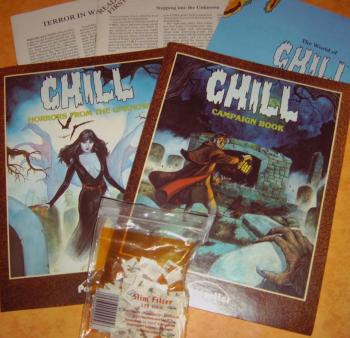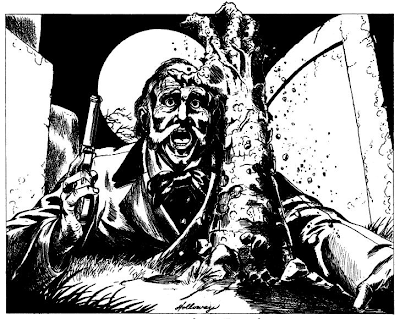
The other day I posted an article of mine from a past issue of Knights of the Dinner Table Magazine revisiting the Conan game by TSR. Today I have another article from a past issue (#118) revisiting The horror RPG Chill from Pacesetter games.
Chill-Adventures into the unknown
Jeff Mejia
In 1984 a small company called Pacesetter games released “Chill”, a Role Playing Game set in the genre of classic horror. All the guys in my gaming group back then grew up on a regular diet of Saturday night “Creature feature” shows on TV. We loved the old black & white Universal monster movies featuring Dracula, The Mummy, Frankenstein’s monster, etc. as well as the Hammer horror films with Christopher Lee and lots of busty vampire chicks.
Up until Chill the only horror game around was Call of Cthulhu, and while there is no denying that Call of Cthulhu is a classic, my group never really cared for it, mainly because no matter how well you played your character, He/She would eventually go insane, in fact everybody’s character eventually goes insane in Call of Cthulhu. My group was made up of mostly “meat and potato” gamers- we liked to hunt down the bad guy, hack him into tiny pieces, and then loot his lair for +2 swords. The idea of our characters eventually going nuts never held much appeal.
Chill didn’t have that aura of hopelessness that Call of Cthulhu had, and none of the pretentious angst that “Vampire: the Masquerade” would later have. And though I was familiar with Lovecraft’s works most of the guys in my group weren’t, so it was hard for them to visualize why they should be running from a “Slithering Miyagi” or an oozing puddle of space pudding with a hundred eyes. It just wasn’t working for them. With Chill, if I told them they were being attacked by a pack of hatchet wielding zombies led by a Voodoo priestess, they had a frame of reference.
The Chill game comes boxed. Back in the day, most Role-playing games came packaged in a box. And believe it or not, many a games complexity and dollar value was judged by the weight of the box. Chill came in at a healthy weight, better than “Cyborg Commandos” but way less than “Bushido”. The game consisted of two rulebooks, a world map, introductory adventure, three 10-sided dice, a set of cardboard counters and what in today’s terms would be called a set of “fast play” rules.
In Chill, the player characters are all part of a secret organization called S.A.V.E (Societas Albae Viae Eternitata, the Eternal Society of the White Way).
S.A.V.E. Operatives fight a never-ending war against the supernatural forces of evil. In the world of Chill, Vampires are real, Were-creatures are real, and Malign spirits are real. The forces of evil exist and the agents of S.A.V.E. seek them out and destroy them. The setting for the game can be in any period from the mid 1800’ to present day, and globe spanning adventures are not only possible but encouraged. The setting has a classic horror movie feel to it thanks to the great artwork of Jim Holloway throughout the rulebooks.
The campaign book covers character creation based on eight abilities generated by random dice rolls and a system formula. Along with the regular Strength, Dexterity, Agility, Stamina, and Personality, they offered some additional “genre” specific abilities such as Willpower (used when making the obligatory “fear check”), Perception (which aids in noticing specific clues or unusual details), and Luck (which aids in character survival by allowing “Luck checks” to avoid immediate death).
All of these abilities are used when deciding the success of a characters action, this is known as making an ability check. There are two types of ability checks the first is known as the standard check, and is used when rather straightforward actions are resolved the second is known as a specific ability check this type of check uses a unique chart system known as the “Chill action table” to gauge the degree of success. The better the roll, the higher the degree of success, for instance, if your character is trying to jump out of a window to escape from a foe, the referee may want you to roll an ability check based on agility. If you succeed the referee will compare your roll to the success chart. A limited success may indicate you jumped out of the window but may have injured yourself on the fall. A medium success could indicate you landed hard but are uninjured, a high success may mean that you landed on your feet and can move normally next round.
Characters advance and gain experience in Chill by participating in adventures and defeating evil creatures and their minions. “Insight Points” are awarded for success and these points can be later used to improve current abilities and skills or to purchase new skills for future use.
Chill offers a wide variety of combat and non-combat skills to choose from when creating a character. All skills have corresponding success scores that are based on one or more abilities and ranked as student, teacher, or master. Each rank adds a percentage point bonus to the skill, which insures a player at master rank, is effectively a leader in that field. Players start the game with student ranks and use “insight points” to increase their rankings in various chosen skills.
As with the ability checks, Chill has two types of skill checks. The basics skill check which is a straight success/failure roll and a specific skill check which utilizes the “Chill action table” to determine the degree of success. There are a fairly adequate number of skills supplied for the game, and by following the general formula it’s not at all difficult to add new skills to the list as needed. It’s worth noting as well that Chill spends a good amount of time explaining the use of professional and research skills. In Chill your characters ability to read a map, use a library, and speak Latin will be as valuable as what caliber of pistol he carries or what level of mastery he has in Judo.
Character actions are covered in the next section. The mechanics of campaign play are introduced in this section. Game time, travel times, fear checks, movement, damage and healing, and combat are all examined. An area, which was revisited quite often in our campaign, were the rules on lighting and visibility. Quite a few of our combats took place on fog-shrouded streets and in dark cemeteries.
The various types of Non-player characters are covered in part five of the rules. The reactions of Animals, persons and creatures are covered here along with societies reactions in general. The hardest part about interacting with NPC’s in Chill is trying to convince them that your character isn’t a loon, this is where having an organization such as S.A.V.E around is invaluable. Not only are there people who will actually believe your story about the secret cabal of demon worshippers at Fairfax manor, they may even be able to help you do something about them.
Which leads us to part six of the rulebook. Characters in Chill may face vampires, mad scientists and evil witches, but they don’t do so without powers of their own. This section of the rules outlines the use of The Art. The Art is basically a collection of disciplines used to combat the minions of evil. The Art is a combination of Psionic abilities and arcane protections that enable the agents of S.A.V.E a fighting chance when confronting the disciples of the evil way. The chapter ends with a brief history of S.A.V.E, it’s rules and tenets. The final section gives some brief advice for the “Chillmaster” (CM) on running a successful horror campaign.
The second book in the boxed set is titled Horrors from the unknown. This volume is essentially a combination spell book and monster guide. The first part describes the various spells and magical effects that the creature’s posses and use to combat the heroes of S.A.V.E. the second half of the book details creatures both common and supernatural that are used in the Chill game, unfortunately they only list around eighteen creatures total.
Chill received a decent amount of support for its run. There were nine published modules ranging from encounters with Dracula and the Mummy to exploring haunted amusement parks and touring with a rock band.
There were also several sourcebooks, which added to the Chill line:
• A “Chillmasters” screen with the obligatory mini-adventure.
• Vampires-a sourcebook giving detailed descriptions of several vampires from different parts of the world.
• Creature Feature- a Chill game variant that lets the players assume the role of the monsters. The book also offers more rules for combat, new skills and an additional discipline of the Art.
• Things- basically an expanded (over fifty) listing of creatures and new evil way disciplines.
• Evenings of terror with Elvira- a set of nine linked scenarios hosted by the mistress of the dark herself.
It’s worth noting as well, that in the 1990’s Mayfair games purchased the rights to Chill and gave it a new look and a new audience for a brief time.
By today’s standards, when held up against somber fare like the World of Darkness and Kult, Pacesetters Chill might seem a little light and old fashioned. But for the folks who like their horror a little less Anne Rice and a little more Boris Karloff, Chill is just the ticket.

I love Chill. I didn't discover it until the Mayfair edition and then, despite thinking it was a good read, I didn't get around to actually playing the game until ten years later.
ReplyDeleteThe game was kicked off with the excellent Thutmose module and ran for about two years, in which the players many of battled the standard Chill badies plus an ancient race of reptilian shapeshifting psychics.
It was one of our more memorable campaigns and we sometimes go back to it for a spell when the mood strikes.
I dearly love Pacesetter Chill to this day and own everything published for it. I actually met my first girlfriend running what was then my annual Halloween game (The scenario that year was "Deathwatch on the Bayou").
ReplyDeleteI have always loved Chill.
ReplyDeleteThanks for posting this!!
One of my favorite games! It's been discussed quite a bit on rpg.net, and for me, this will always be the "Hammer Horror" game! I loved the fact that it used classic monsters like Dracula, the mummy, and werewoves, and made them scary again!
ReplyDeleteLoved this game, along with the Creature Feature expansion, where you could play the bad guys.
ReplyDelete[i]Theron said...
ReplyDeleteI dearly love Pacesetter Chill to this day and own everything published for it. I actually met my first girlfriend running what was then my annual Halloween game (The scenario that year was "Deathwatch on the Bayou").[/i]
Now that has to be a wonderful memory!